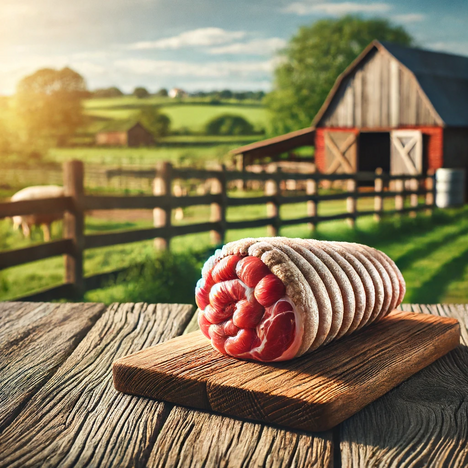Sheep's tail

Sheep's tail is a popular ingredient in dog food and snacks that can have many benefits for your four-legged friend's health and well-being. But what exactly is sheep's tail and what should you look out for when giving it to your dog? In this article, you'll learn everything you need to know about sheep tail for dogs.
What is sheep's tail?
Sheep's tail is the tail of a sheep, which is usually dried or smoked to preserve it. It consists of cartilage, bone, fat and fur and has an intense smell and taste that attracts many dogs. Sheep's tail is a natural chew that cleans and strengthens your dog's teeth and gums. It also contains valuable nutrients such as protein, calcium, phosphorus and omega-3 fatty acids.
What are the benefits of sheep's tail for dogs?
Sheep tail can provide many benefits for your dog if you feed it in moderation. Here are some of them:
- It promotes your dog's chewing muscles and jaw health by providing an intense chewing experience.
- It supports your dog's dental care by removing plaque and tartar and reducing the risk of dental problems.
- It provides your dog with high-quality protein, which is important for muscle building and regeneration.
- It provides your dog with calcium and phosphorus, which ensure strong bones and joints.
- It contains omega-3 fatty acids, which have an anti-inflammatory effect and improve the health of your dog's skin and coat.
- It satisfies your dog's natural chewing instinct and helps to relieve stress and prevent boredom.
What are the disadvantages of sheep tail for dogs?
Sheep tail is not without risks for your dog. You should consider a few things before giving it to your dog. Here are some of them:
- It can lead to obesity if you feed it too often or in too large quantities. Sheep's tail is very high in fat and calories and should therefore only be given as an occasional snack.
- It can lead to digestive problems if your dog does not tolerate it well or eats it too quickly. Sheep's tail can cause bloating, diarrhea, constipation or, in the worst case, intestinal obstruction.
- It can cause injury if your dog splinters or chokes on a sharp bone. Sheep tail can have sharp edges or splinters that can injure your dog's mouth, esophagus or gastrointestinal tract.
- It can lead to parasite infestation if it has not been processed hygienically. Sheep's tail can be contaminated with bacteria or worms that can infect your dog.
How do you feed sheep tail correctly?
To reap the benefits of sheep tail for your dog and minimize the risks, you should follow these tips:
- Only buy high-quality sheep tail from trusted manufacturers or retailers. Make sure it is free from additives, preservatives or colorants.
- Store the sheep's tail in a cool, dry and dark place. Avoid direct sunlight or moisture, which can affect the quality.
- Only give your dog as much sheep's tail as he can eat in one sitting. Remove the rest and dispose of it or save it for next time.
- Always supervise your dog when he is chewing sheep tail. Make sure he doesn't eat it too quickly or greedily or hurt himself.
- Always provide your dog with fresh water when he is chewing sheep's tail. This will help him to digest the sheep's tail better and quench his thirst.
- Reduce the amount of your dog's normal food when you give him sheep tail. This will prevent him from consuming too many calories and becoming overweight.
Sheep's tail is a tasty and healthy snack for your dog that can bring him many benefits. However, you should only feed it in moderation and with caution to avoid possible disadvantages.
If you notice any signs of hypersensitivity or poisoning in your dog, you should see your vet immediately. We are not a substitute for a vet, but we try to be as accurate as possible. Every dog reacts differently and we recommend you get a second opinion or consult your vet if in doubt.
Stay healthy and take good care of your four-legged friend!😊